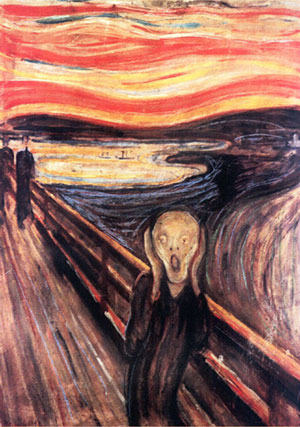Munch was a tense and nervous man who suffered periodically from bouts of depression. He was prone to extreme morbid anxiety, which he sometimes ascribed to the death of his mother from tuberculosis when he was five years old. That trauma had been intensified by the death of his sister from the same disease a few years later. He painted The Scream after another death in the family, that of his father, an event which seems to have stirred up many of his most deepseated fears. The painting is based on an experience which Munch described in a diary entry dated 22 January 1892:
“I was walking along the road with two friends. The sun set. I felt a tinge of melancholy. Suddenly the sky became a bloody red. I stopped, leaned against the railing, dead tired, and I looked at the flaming clouds that hung like blood and a sword over the blue–black fjord and the city. My friends walked on. I stood there, trembling with fright. And I felt a loud, unending scream piercing nature.”
The artist may have decided to paint his sudden and overwhelming emotion of terror in an attempt to exorcise it. But it was in any case a subject well suited to his ideas about art at the time. He was in open rebellion against the derivative, watered-down, safely domesticated versions of Impressionist painting that held sway in his native Norway in the late nineteenth century. “One cannot forever paint women knitting and men reading,” he declared. “I want to represent people who breathe, feel,...


